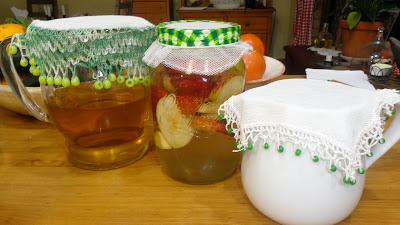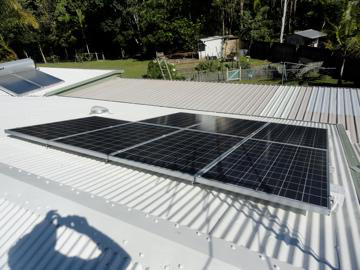We had a busy week here last week, which ended with a blogging workshop at the neighbourhood centre on Saturday morning. It was very satisfying teaching eager people how to set up and write a blog. We used the Flexischool computers so everyone had their own computer and those three hours flew by and resulted in a few more people with their own blogs. I might just do it again. :- )
 When I got back home again around 2pm Hanno wasn't feeling well. So I got him cosied up on the sofa watching pre-recorded television and later we had leftovers for dinner in front of the TV. I started a new knitting project, so I was quite contend sitting there clicking away. Yesterday was spent doing a bit of writing - an author's bio for the book and a few odds and ends, then the rest of the day was knitting and talking to the family on the phone. Kerry, Sunny and Jamie are visiting us on Wednesday. We'll all be going out for lunch, then HANNO AND I WILL LOOK AFTER JAMIE while Kerry and Sunny have some time together at dinner and the movies. :- ) They will all here stay overnight. I wish Wednesday would hurry up and arrive.
When I got back home again around 2pm Hanno wasn't feeling well. So I got him cosied up on the sofa watching pre-recorded television and later we had leftovers for dinner in front of the TV. I started a new knitting project, so I was quite contend sitting there clicking away. Yesterday was spent doing a bit of writing - an author's bio for the book and a few odds and ends, then the rest of the day was knitting and talking to the family on the phone. Kerry, Sunny and Jamie are visiting us on Wednesday. We'll all be going out for lunch, then HANNO AND I WILL LOOK AFTER JAMIE while Kerry and Sunny have some time together at dinner and the movies. :- ) They will all here stay overnight. I wish Wednesday would hurry up and arrive.I've been knitting away quite happily with the Ecoyarns that Vivian bartered with me. My absolute favourite is this organic cotton which is so soft and cuddly, and the colours are just beautiful. I rolled a natural and a deep pink skein into balls the other day and started knitting a cowl scarf that I'll probably put into my shop. I like the cowl scarves to wear to work. I hate having a cold neck in winter so one of these scarves is a better option at work because it doesn't hang down and get tangled in whatever I'm doing. I'm really pleased with the way it's knitting up and I just know how wonderful it will be. So I've said I'll "probably" put it in the shop because I might keep it myself.
Knitting is a wonderful way to relax - it's like a meditation. That repetitive action of the needles and yarn, twirling, looping and methodically slipping the needles through; it quietens the mind and brings a gentle kind of peace to me. I definitely needed to relax after last week's busyness, this was the perfect way to do it. I hope you are all looking after your own physical and mental health by taking time to relax whenever you can. It's important. Modern life can be stressful and you need to have several simple and easy ways to unwind and relax.
A little while ago, I bought this gorgeous book with the points many of you give me by buying your books through my Amazon store. Thank you for doing that; I can usually buy one book every month. I have sworn off buying books and this is a way I still have access to books I want to read and give as gifts. This book is called "Little Luxury Knits" by Alison Crowther-Smith and it has many beautiful knitting projects in it. I've not yet decided whether I will keep it myself or if I will use it as a prize. I really like these three patterns - the fingerless mittens, the bed socks and the shawl - they're all gorgeous and all within the capabilities of a newish knitter.
These kinds of books inspire new knitters and make many of us passionate about this craft. There is nothing quite like taking some beautiful balls of wool or cotton, and by clicking and sliding your needless, and winding, looping and relaxing, there you have it - something unique and wonderful, and hand made.
Look at these two above and below - bed socks and a shawl. They're simple and beautiful.
If you're just taking up the needles now, or are just thinking you might be interested, I encourage you to dive right into knitting. It's a soothing and all-embracing craft that not only makes you feel good, with the addition of time and effort, it will give you beautiful garments and items for your home.
I urge you to use good quality yarns and needles. If you can afford it, spending that bit extra on materials you really love and enjoy working with will add to the rich experience of knitting and pay off in a better product that will last many years. I have recently discovered Clover bamboo needles from Japan and even with these soft organic yarns I'm using now, they never snag and glide effortlessly over and under whatever yarn I'm using. They cost ten dollars but I know I'll be knitting with them for many years to come. That is wise economy.
What are you knitting now? If you care to share your current knitting project with me, I'd love to see it. Just leave a link and I'll pop over to visit, and I'm guessing many others will too.
I hope you all make the most of the week ahead. I'll have another busy one here but I'm looking forward to what it brings and the memories I'll be able to store away at the end of it. Thank you for visiting me here and thank you so much for the comments you leave. I do not have enough time to answer all your comments, or emails, but I do read every one of them and many of them make me smile. I know that I am fortunate to have you here with me and with each comment I discover a little bit more about you. I like that!
ADDITION: I made a mistake in the pattern I left in the comments, so to stop anyone knitting it without seeing the correction, here it is again:
ADDITION: I made a mistake in the pattern I left in the comments, so to stop anyone knitting it without seeing the correction, here it is again:
This is my (made up) pattern for the pink cowl scarf: cast on 50 stiches, then knit one row on plain (knit) and one row of purl, which is ordinary stocking stitch. Do four rows of stocking stitch, then two rows of knit - that will give you that little ridge line.
So, to summarise:
Cast on 50 stitches.
Row 1: knit
Row 2: purl
Row 3: knit
Row 4: purl
Row 5: knit
Row 6: knit
Then repeat until the scarf is long enough to wind around your neck + a bit of hang.
Cast off, neatly sew the two edges together and bind in any threads. If you want to be a bit fancier, make the scarf slightly longer and twist it once before you sew the ends together. You will end up with something like these.
So, to summarise:
Cast on 50 stitches.
Row 1: knit
Row 2: purl
Row 3: knit
Row 4: purl
Row 5: knit
Row 6: knit
Then repeat until the scarf is long enough to wind around your neck + a bit of hang.
Cast off, neatly sew the two edges together and bind in any threads. If you want to be a bit fancier, make the scarf slightly longer and twist it once before you sew the ends together. You will end up with something like these.






















































